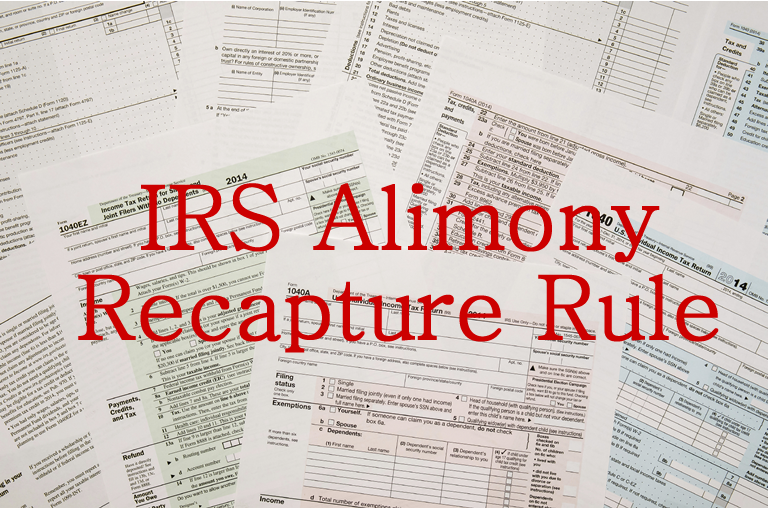Divorce and the IRS: The Alimony Recapture Rule

Alimony is often a difficult topic for a divorcing couple to navigate and agree on.
You may breathe a sigh of relief once you and your spouse agree on the details of spousal maintenance in your separation agreement and the divorce becomes final.
I’d like to make you aware of a little-known IRS rule concerning alimony (which is how the IRS refers to spousal maintenance) called the Alimony Recapture Rule. It could have an unexpected and significant financial impact on the payor’s IRS income taxes in the third year, whether or not there actually was an alimony payment in all three years.
NOTE: Please consult your professional advisers concerning whether the Tax Cuts and Job Act (TCJA) federal law in effect on Jan 1, 2019 affects your situation. See Spousal Maintenance Part 3 – Post-Divorce.
Alimony Recapture Rule Summary
The IRS created this rule to discourage divorcing spouses from improperly disguising property settlement payments as alimony because of alimony’s tax benefits. Unfortunately, the rule can still apply in your situation even if there is no such intent.
The rule concerns the alimony payments made during the first three years after you and your spouse have separated, even if not yet divorced. It’s triggered if the total amount of alimony in any one year is reduced by more than $15,000 from the previous year.
Alimony Recapture Example
Let’s say in year 1 the wife receives $20,000 in alimony and in year 2 only $2,000. This triggers the notion in the mind of the IRS that perhaps the first payment was actually a way to share a marital asset and have the husband receive a tax benefit.
This rule converts what was a $20,000 tax deduction in year 1 for the husband into an unexpected additional taxable income of $20,000 for the husband in third year.
It also converts that $20,000 taxable income in year 1 to the wife into an income tax deduction for the wife in that same third year.
To avoid triggering this rule, your alimony payment schedule for at least the first three calendar years after separating must not have more than a $15,000 difference in any of the first three years.
What Triggers the Alimony Recapture Rule
According to IRS Publication 17, Chapter 18:
The 3-year period starts with the first calendar year you make a payment qualifying as alimony under a decree of divorce or separate maintenance or a written separation agreement. Do not include any time in which payments were being made under temporary support orders. The second and third years are the next 2 calendar years, whether or not payments are made during those years.
Reasons other than the language of your divorce decree can cause the reductions. These include even reasons beyond the control of the payor, like a modification of the decree, failure to make timely payments, inability to make payments, or a modification in the amount paid because your ex-spouse no longer needs as much from you.
There are also exceptions under which you will not have to pay back tax benefits as the alimony payor even if you otherwise would have to. Please check with the appropriate professional to learn what might apply in your situation.
The Recaptured Alimony Calculation
To determine whether the rule applies, the IRS has developed a worksheet, which can be found in IRS Publication 504 (2015), Divorced or Separated Individuals (link is below). On page 17 of that publication are directions for the income tax filing changes that both parties take as a result of the calculation.
Alimony is Complicated
There are rare cases when a party might still be better off working to get his or her alimony payments reduced and taking the lumps from the IRS in terms of recapture. Such a decision will depend on your individual financial circumstances. Run the numbers, do the worksheet, and talk with your CPA and divorce attorney before making such a decision.
Resources
- IRS Publication 17 Tax Guide (2015)
- IRS Publication 17 Tax Guide (2015), Chapter 18 (Alimony) Recapture Rule
- IRS Publication 504 (2015): Divorced or Separated Individuals
Photo credit: iStockPhoto
This blog and its materials have been prepared by BJ Mediation Services for informational purposes only and are not intended to be, are not, and should not be regarded as, legal or financial advice. Internet subscribers and online readers should not act upon this information without seeking professional counsel.
